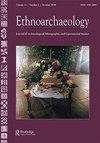Salt, Sand, and Saddles: Exploring an Intriguing Work Face Configuration among Grinding Tools
IF 1.3
0 ARCHAEOLOGY
引用次数: 10
Abstract
ABSTRACT The field of macrolithic use-wear analysis has developed dramatically in recent years, but the morphological evolution of surfaces resulting from use has not received much attention. To a large extent, this neglect is due to the substantial amount of time that experiments exploring this aspect would require. This article presents a time-saving experimental program that involves rock salt and sand, used in combination with archaeological data, ethnographic evidence, and an engineering perspective to investigate the so-called saddle work face configuration of grinding tools. This intriguing shape is found among both passive and active tools and includes a concave longitudinal axis and a convex transverse one. Our work uses a Greek Neolithic assemblage as its case study and suggests that the saddle shape can develop as a result of specific kinematics.盐、沙和鞍座:探索磨削工具中一个有趣的工作面配置
近年来,宏观石器的使用-磨损分析领域得到了极大的发展,但由于使用而导致的表面形态演变却没有受到太多的关注。在很大程度上,这种忽视是由于探索这方面的实验需要大量的时间。本文提出了一个节省时间的实验方案,包括岩盐和沙子,结合考古数据、人种学证据和工程角度来研究所谓的鞍形工作面磨削工具配置。这种有趣的形状在被动和主动工具中都有发现,包括一个凹的纵向轴和一个凸的横向轴。我们的工作使用希腊新石器时代的组合作为案例研究,并表明马鞍形状可以作为特定运动学的结果而发展。
本文章由计算机程序翻译,如有差异,请以英文原文为准。
求助全文
约1分钟内获得全文
求助全文
来源期刊

Ethnoarchaeology
ARCHAEOLOGY-
CiteScore
1.60
自引率
0.00%
发文量
10
期刊介绍:
Ethnoarchaeology, a cross-cultural peer-reviewed journal, focuses on the present position, impact of, and future prospects of ethnoarchaeological and experimental studies approaches to anthropological research. The primary goal of this journal is to provide practitioners with an intellectual platform to showcase and appraise current research and theoretical and methodological directions for the 21st century. Although there has been an exponential increase in ethnoarchaeological and experimental research in the past thirty years, there is little that unifies or defines our subdiscipline. Ethnoarchaeology addresses this need, exploring what distinguishes ethnoarchaeological and experimental approaches, what methods connect practitioners, and what unique suite of research attributes we contribute to the better understanding of the human condition. In addition to research articles, the journal publishes book and other media reviews, periodic theme issues, and position statements by noted scholars.
 求助内容:
求助内容: 应助结果提醒方式:
应助结果提醒方式:


